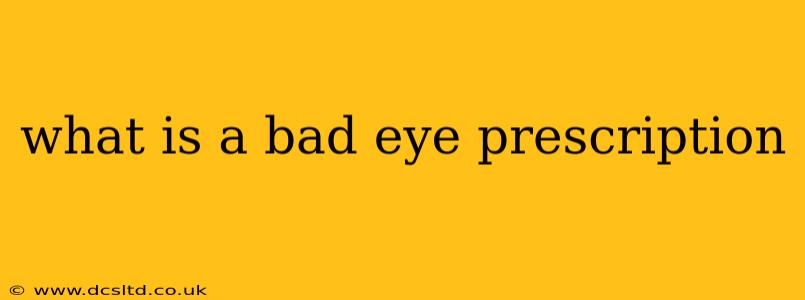What is Considered a "Bad" Eye Prescription?
There's no single definition of a "bad" eye prescription. What constitutes a "bad" prescription is relative and depends on several factors. It's not simply about the numbers themselves (like -2.00 or +4.00), but rather the impact those numbers have on your vision and daily life. A prescription that's mildly inconvenient for one person might be severely limiting for another.
Let's break down the key factors that determine whether an eye prescription is considered "bad":
1. The Magnitude of the Correction:
A high refractive error (the amount of correction needed) generally means a "worse" prescription. This could involve:
-
High Myopia (Nearsightedness): A prescription with a significant negative number (-4.00 or lower) indicates a higher degree of nearsightedness. This means you have difficulty seeing objects far away clearly. Very high myopia can increase the risk of certain eye conditions later in life.
-
High Hyperopia (Farsightedness): A prescription with a large positive number (+4.00 or higher) suggests a significant level of farsightedness. This makes it challenging to focus on nearby objects. High hyperopia can lead to eye strain and headaches.
-
High Astigmatism: Astigmatism refers to an uneven curvature of the cornea, causing blurry vision at all distances. A high astigmatism correction (high cylinder power) means the irregularity is more pronounced, resulting in more significant visual impairment.
2. Impact on Daily Life:
The severity of a "bad" prescription is also determined by its impact on a person's ability to perform daily tasks:
-
Difficulty Driving: Blurred distance vision significantly impacts safe driving.
-
Problems with Work or School: Inability to see the whiteboard, computer screen, or reading materials clearly can severely hinder performance.
-
Reduced Quality of Life: Constantly struggling to see can lead to headaches, eye strain, and a generally reduced quality of life. Simple tasks like reading, watching television, or participating in hobbies become challenging.
3. Presence of other Eye Conditions:
A prescription might be considered "worse" if it's accompanied by other eye health problems, such as:
-
Macular Degeneration: This affects central vision.
-
Glaucoma: This damages the optic nerve.
-
Cataracts: These cloud the eye's lens.
These conditions, regardless of the refractive error, can significantly impact vision and overall eye health.
What to Do if You Think Your Prescription is "Bad":
If you're concerned about your vision or the strength of your prescription, schedule a comprehensive eye exam with an ophthalmologist or optometrist. They can assess your vision, identify any underlying conditions, and recommend the best course of action, which might include:
- New prescription: Adjusting the prescription strength for better visual acuity.
- Eye drops or medication: Treating underlying conditions affecting vision.
- Surgery: For certain conditions, corrective surgery like LASIK might be an option.
In conclusion, there isn't a universally agreed-upon threshold for a "bad" eye prescription. It's a personalized assessment based on the magnitude of the refractive error, its impact on your daily life, and any accompanying eye conditions. Regular eye exams are crucial for early detection and management of any vision problems.
